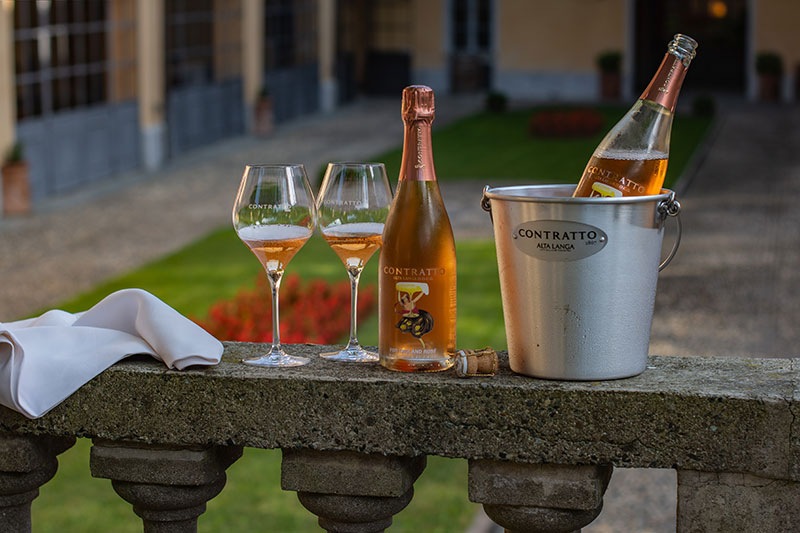Metodo Classico, also known as ‘champenoise’ or ‘traditional method’ is a production process for sparkling wines where there is a second fermentation inside the bottle with the subsequent formation of bubbles and aromas.
But this is merely the tip of the iceberg: in fact, there is so much more involved!
The vineyard is where it all starts. For the production of sparkling wine, grapes cannot be chosen randomly: every single action must be aimed at producing a specific type of wine.
Let’s ask Contratto!
To answer this question in more detail, we asked an expert in the field, Contratto!
xtraWineXperience is now in Piedmont and there is no other better expert to ask if not La Spinetta, Contratto.
Bossolasco (in the heart of Piedmont or Piemonte) is the perfect area for the production of sparkling wines with a capital S.

Altitude plays a key role: the vineyards are located at around 800 metres above sea level, with mild temperatures and an incredibly varied soil, rich in white sand, marl and limestone. The vines are carefully cultivated, with the aim of giving back to mother earth what she gives us every year.
The Harvest and Winemaking
During the harvest, the best bunches are selected by hand, thus bringing the best grapes to the winery. The balance between sugars and acidity always reaches a perfect level: this phase is very important for the production of a complete sparkling wine from the start, with no additional help needed in the cellar.
After this phase, a set of processes are set in motion to make the Metodo Classico a reality. As already introduced, Metodo Classico requires a ‘double fermentation’, but timing, patience and skills are key.
The first fermentation follows, a fundamental phase in the transformation of must to wine. After a 9 month maturation in vats, the still wine is bottled together with a small amount of yeast and sugar. This moment is a very delicate one: after a couple days, the yeasts begin to feed on the added sugar, resulting in carbon dioxide, the famous bubbles!

The role of yeasts
Once the second fermentation is complete, the exhausted yeasts begin to ‘release’ the typical traditional method aromas, such as bread crust, dough, small pastries; this phase is yet another delicate one and a great deal of patience is also required.
Contratto has a lot of patience which is why the bottles stay maturing on their lees for at least 4 years. This results in very fine and extremely elegant bubbles, capable of enveloping the palate and gifting an incredibly pleasant tasting moment. The aromas also transform, becoming very fine and extremely complex. A true sensory experience!
But let’s talk about Remuage…and Mauro!
Mauro and Remuage
Each individual bottle is placed on wooden racks, real axis with holes where the bottles are inserted. And so begins ‘remuage’ or ‘shaking’ an ancient rotation technique for moving the yeast in the neck of the bottle.
Keeping this tradition alive in Contratto is Mauro, an expert Champagne maker for more than 40 years, one of the few people left in Italy (possibly everywhere) to do this by hand. The bottles are turned anti-clockwise 1/8th of the way every day, tilting the bottle slightly and moving the residue behind the crown cap day after day. Remarkably dedicated to cellar life, Mauro allows himself to be guided by this unconditional love. The remuage is music in the silence of the cellar – played out every day, between one bottle and the next.
After this long wait, we are finally ready for the disgorgement stage during which the internal yeasts are removed. This entire first phase takes place with the crown cork, which ‘seals’ everything inside. During these 4 years there is no contact with the outside, just like what happens with a normal cork.
Disgorgement and liqueur d’expedition
At the end of remuage, the bottles undergo disgorgement ‘à la glace’, which involves freezing 3-4 cm of the bottle neck. This method allows the yeasts to be ‘trapped’ and the bottle is finally turned upside down. Then the crown cap is removed and the magic happens: the internal pressure finally ejects the small ice cube from the bottle!
Traditional disgorging method à la volée (flying disgorgement)
Before closing the bottle with the mushroom stopper we all know, that small amount of wine lost during disgorging needs to be supplemented (on average 10 ml of wine per bottle and about 1 bar of pressure are lost). This small addition is called ‘liqueur d’expedition’, a secret recipe that may contain wine or sugar, which will then define the dosage on the label (pas dosé, extra brut, brut.). Contratto’s philosophy, however, is based on elevating each characteristic and uniqueness of the vintage. Bearing this in mind, it makes no sense to add a blend that would risk undermining these differences. This is why a few bottles from each batch are ‘sacrificed’ to top up the other ones. And that’s all there is to it! No sugar. All the wines are pas dosé (without dosage); preserving the identity and character of each reference.
After sealing the bottles with a cork, the bottles go back to the cellar to rest for a few more months, and then return to production for packaging and sale.
However, after so many years together, it is always difficult to part ways!
On xtraWine you can find a wide range of Contratto sparkling wines!

Interviste esclusive dal mondo del vino ed approfondimenti da chi fa del vino una ragione di vita, di business e di cultura.









